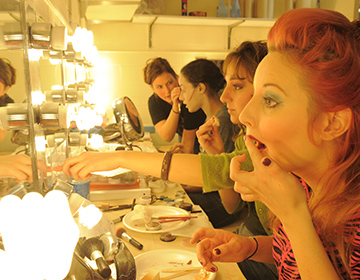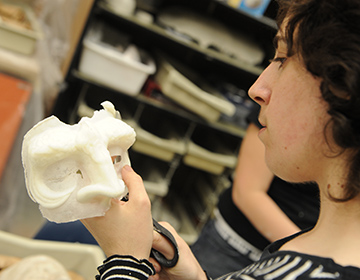Making Faces
From monsters to moulage, two TU theatre professors give new meaning to the make-up exam

It’s the first day of Towson University’s Minimester, and students in Steve Bauer and Marianne Wittelsberger’s Makeup Design II class are already neck-deep in their first assignment.
Today, students are pouring the facial molds they’ll use to create masks and prosthetics. As the two professors survey the room, they explain the finer points of having one’s head doused in a bluish, rubber-like substance called alginate. (The two biggies: don’t skimp on the Vaseline, and make sure you remember the hand signal for “I can’t breathe.”)
The students, quite literally, dive right in.
Bauer and Wittelsberger, known collectively by their stage persona The Jokesters, have taught makeup design in Towson’s Department of Theatre Arts for 15 years. The duo, both TU graduates, worked in special effects and makeup at major Hollywood studios for a decade before returning to Maryland in 1999. They’ve been training the next generation of makeup artists ever since.
“People hear makeup and they think of beauty and fashion,” says Wittelsberger, “but if you’re on stage or on screen, this is something you have to know how to do. Even for actors—unless you’re working on a big-name production, you’re responsible for your own makeup.” The experience, she says, provides students a huge advantage when they hit the ultra-competitive world of performing arts.
“ These courses completely transform you. Not just what you look like, but what you're capable of. ”
The courses start with the basics of “straight makeup”—the natural style that accentuates facial features, masks blemishes and the like. Students then advance to the complex realm of character makeup and special effects. By the end of the first course, students are applying makeup that transforms them into someone else entirely.
“I couldn’t believe it was me in the mirror,” says TU senior Tai Bradley, recalling an assignment in which she applied makeup to appear middle-aged. “I realized that these courses completely transform you. Not just what you look like, but what you’re capable of.”
It’s an impressive transformation but, of course, students learn much more than execution. They learn how to take their designs from concept to completion.
“Most projects start with research and a sketch, or a few pictures,” says Wittelsberger. “We can’t stress enough the importance of having a game plan.”
Adds Bauer, “A director might say, ‘We need a bruise for the next scene.’ But what kind of bruise? Is it deep or superficial? How big is it? How old is it? Bruises change color over time. Does it looks realistic?”
Whenever possible, Bauer and Wittelsberger support classroom learning with real-world employment and volunteer experience for their students.

For example, the couple produces a popular Halloween scare house, Timonium Scaregrounds. According to Bauer, the cast of the production hovers somewhere around 200, many of whom are TU students.
Bauer and Wittelsberger also recruited former students for a locally filmed horror-thriller
movie, The Bone Garden. They provided makeup and special effects for the production.
“Things like The Bone Garden and Scaregrounds help our students because they get to
see us working and doing the exact same things we taught them in class,” says Bauer.
And while it’s easy to get swept up in the more fantastic aspects of makeup design—the zombies and vampires and oh-so-whimsical bloody ax murderers—for the Jokesters, it’s also about giving back.
Bauer, Wittelsberger and many students regularly participate in moulage—or mock injury—exercises at the University of Maryland Shock Trauma Center. The Jokesters and their students build their own prosthetics, apply life-like makeup and act out critical injuries as part of a training program for emergency room doctors and nurses.
The injuries range from car accidents with protruding bone fragments to gunshot wounds. Medical staff must then diagnose and begin treating the injuries.
The exercise gives Towson students experience in creating and applying special effects makeup in a real performance. But it's essential for doctors and nurses, says Claire Leidy, a program manager at the renowned trauma center.

"Physicians from across the nation and around the globe travel here to learn the latest skills in trauma care, and realistic injured-patient scenarios are an important part of our training," she says. "When you've got seconds to make a critical decision, details matter. It's the attention to detail that Steve, Marianne and their students commit to these scenarios that makes the difference. We're very fortunate to call them members of our team."
Says Bauer, "We're special effects people, so we can never have enough fake blood. But the real stuff? That needs to stay on the inside. We're happy to apply what we know to help doctors and nurses save lives."
Fast-forward to the last day of the Minimester, and the students have amassed an impressive portfolio of professional-grade prosthetics. Bauer and Wittelsberger circulate around the room, appearing genuinely in awe of the array of vampire fangs, witch noses, and various otherworldly appliances on the table before them.
“Students take our classes and they really discover a talent for this stuff,” says Bauer. His speech is a bit muffled at this point, thanks to the comically oversized dentures he slipped on while no one was looking. Jokesters, indeed.
Wittelsberger doesn't miss a beat, as she continues inspecting the students' work.
"Isn't this stuff amazing?" she asks. “We show them the steps, and then they take
off and just do wonderful work.”